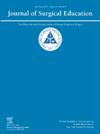机器人胰十二指肠切除术中胃空肠和肝空肠吻合术的生物组织课程转化为手术室的表现。
IF 2.6
3区 医学
Q1 EDUCATION, SCIENTIFIC DISCIPLINES
引用次数: 0
摘要
目的:机器人模拟训练课程旨在帮助外科医生熟练掌握机器人手术室,但交叉成功仍有待检验。设计:回顾性队列研究分级机器人生物组织训练模型和术中吻合视频。课程包括有意练习肝空肠吻合术(HJ)和胃空肠吻合术(GJ)。对视频进行盲目审查,并根据时间、错误和客观结构化技术技能评估(OSATS)对表现进行评估。计算术前经验、生物组织表现和术中表现的Spearman相关系数(ρ)。单位:2014 - 2018年在匹兹堡大学医学中心。参与者:31名外科肿瘤学研究员参加了基于熟练程度的5步机器人胰十二指肠切除术培训课程。结果:患者完成生物组织平均5.1±3.7 HJ和4.3±3.3 GJ。更多的生物组织练习与两次吻合成功率(ρ = -0.51)和误差(ρ = -0.45)的提高相关。生物组织GJ的平均误差和最后一次尝试的时间越长,术中GJ OSATS的平均误差越低(ρ = -0.64;ρ = -0.66)。最后生物组织GJ误差越大,术中平均GJ时间越长(ρ = 0.58)。第一次和平均生物组织HJ误差与术中HJ的较低OSATS相关(ρ = -0.74;ρ = -0.80)。结论:术中表现与生物组织表现相关。结果提示刻意练习对熟练手术的重要性。本文章由计算机程序翻译,如有差异,请以英文原文为准。
Biotissue Curriculum Translates to Performance in the Operating Room for Gastrojejunostomy and Hepaticojejunostomy in Robotic Pancreaticoduodenectomy
OBJECTIVE
Robotic simulation training curricula aim to aid surgeons in attaining robotic operating room proficiency, but the crossover success remains to be examined.
DESIGN
A retrospective cohort study grading robotic biotissue training models and intraoperative anastomotic videos. The curriculum included deliberate practice of inanimate drills of a hepaticojejunostomy (HJ) and gastrojejunostomy (GJ). Videos were blindly reviewed, and performance was evaluated by time, errors, and Objective Structured Assessment of Technical Skills (OSATS). Spearman's correlation coefficients (ρ) were calculated for prior experience, biotissue performance, and intraoperative performance.
SETTING
University of Pittsburgh Medical Center from 2014 to 2018.
PARTICIPANTS
Thirty-one surgical oncology fellows participated in the 5-step proficiency-based robotic training curriculum for robotic pancreaticoduodenectomy.
RESULTS
Fellows completed an average of 5.1 ± 3.7 HJ and 4.3 ± 3.3 GJ on biotissue. More practice on biotissue correlated with greater improvement on both times to complete an anastomosis (ρ = −0.51) and errors (ρ = −0.45). Average errors on biotissue GJ and longer time on the last attempt correlated with lower average intraoperative GJ OSATS (ρ = −0.64; ρ = −0.66). More errors on the last biotissue GJ correlated with longer average intraoperative GJ time (ρ = 0.58). Errors on the first and average biotissue HJ errors correlated with lower OSATS for the intraoperative HJ (ρ = −0.74; ρ = −0.80).
CONCLUSIONS
Performance on biotissue correlated with intraoperative performance. Results suggest the importance deliberate practice to achieve surgical proficiency.
求助全文
通过发布文献求助,成功后即可免费获取论文全文。
去求助
来源期刊

Journal of Surgical Education
EDUCATION, SCIENTIFIC DISCIPLINES-SURGERY
CiteScore
5.60
自引率
10.30%
发文量
261
审稿时长
48 days
期刊介绍:
The Journal of Surgical Education (JSE) is dedicated to advancing the field of surgical education through original research. The journal publishes research articles in all surgical disciplines on topics relative to the education of surgical students, residents, and fellows, as well as practicing surgeons. Our readers look to JSE for timely, innovative research findings from the international surgical education community. As the official journal of the Association of Program Directors in Surgery (APDS), JSE publishes the proceedings of the annual APDS meeting held during Surgery Education Week.
 求助内容:
求助内容: 应助结果提醒方式:
应助结果提醒方式:


